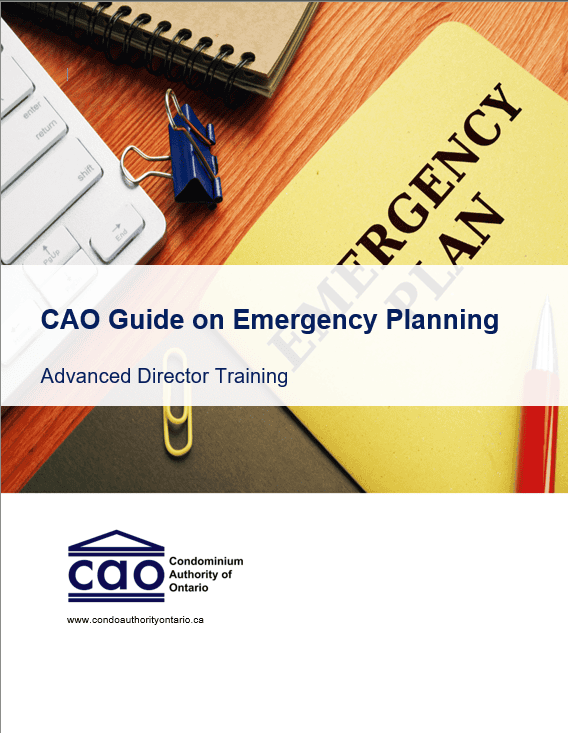GUIDE
CAO Guide on Emergency Planning
This guide assists directors with identifying, planning for and responding to problems that arise suddenly and that may present serious risk to health, life, property, or the environment.
About the guide
Many condo corporations are self-managed, which often requires more work on the part of directors to identify hazards and develop emergency plans. Boards of self-managed corporations may find themselves more ‘hands-on’ in the process of developing the emergency plan and overseeing preparedness.
Typically the role of the condo board is:
- To ensure that appropriate and effective emergency plans have been developed
- To oversee their implementation by the condo manager
- To ensure that effective preparedness has taken place through the condo manager
Preparing for emergency planning and preparedness
Emergency planning is an important exercise best led directly by the condo board.
All directors should be involved in the development of the condo corporation’s emergency plan, particularly for condo corporations that self-manage their affairs. If the condo corporation contracts or employs a condo manager, that individual should play a significant role in developing the plan and supporting the condo’s preparedness. The process of planning for emergencies takes time, often several months, and will depend heavily on the frequency of planning meetings and how much time individual condo directors can devote to the process.
Planning and preparing for emergencies
It is important to remember that no emergency plans will look alike. Emergency planning can be performed for an infinite number of potential emergencies. While it is important for a condo community to be adequately prepared, it is impossible to identify and plan for all possible emergencies.
Planning and preparing for emergencies requires a few steps:
- Assess vulnerability
- Develop Emergency plan
- Test the plan
- Communicate the plan
- Monitor and evaluate
Emergency planning and preparedness relies on a solid understanding of the hazards and vulnerabilities that could be faced by the condo, and which of those factors are most likely to become an emergency. When performing emergency planning, condo boards can identify and accommodate community members with special needs by engaging them directly in the discussion and communicating directly about their needs.
In addition to the make-up of the condo community and the special needs that some residents may have, the condo has a set of physical components, features, and characteristics of its physical environment that may increase or decrease its vulnerability to certain hazards which need to be noted.
Recovering from an emergency or crisis
Resident safety is the first priority in the event of an emergency. Some residents may panic and attempt to re-enter the building during an ongoing emergency to save pets, property or other people. Guidance from emergency responders should take priority about how, when and if to return to the building. Where possible, multiple forms of communication should be used so that there is no delay in receiving communication that the emergency is over.
After the emergency has been handled, the Emergency Coordinator or other assigned party should work with emergency services, inspectors, and insurance adjustors to assess damage.
If help is needed, the condo board may wish to engage relevant professionals for advice or to support residents.
